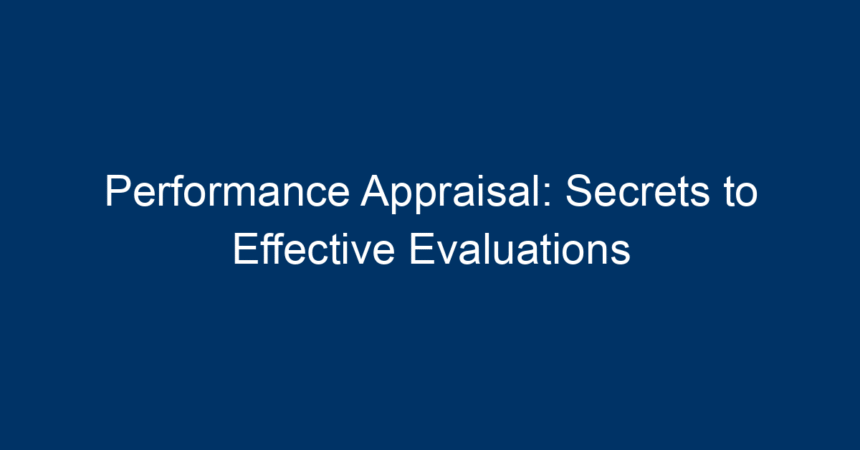In today’s rapidly evolving workplace, performance appraisal systems are more important than ever. A well-structured appraisal not only helps organizations assess employee contributions but also drives motivation, enhances productivity, and fosters career growth. However, conducting effective evaluations is both an art and a science. In this article, we will explore the secrets to mastering performance appraisals, providing you with actionable insights to optimize this essential process.
Understanding Performance Appraisal
What is Performance Appraisal?
Performance appraisal is a systematic evaluation of an employee’s performance within an organization. This process typically involves assessing an employee’s strengths, weaknesses, contributions, and areas for improvement, often leading to decisions regarding promotions, pay raises, training opportunities, and even organizational restructuring.
Importance of Performance Appraisal
The effectiveness of a performance appraisal system cannot be overstated. Here are a few reasons why appraisals are essential:
- Aligning Goals: By assessing employee performance against company objectives, organizations can ensure everyone is aligned with broader business goals.
- Employee Development: Apprisal sessions can identify skills gaps and training needs, paving the way for personal and professional growth.
- Motivation and Engagement: Acknowledging employee performance boosts morale and motivates staff to improve their work.
- Retention: Understanding what makes top performers thrive can help retain talent by creating a positive work environment.
Preparing for Performance Appraisals
Establish Clear Objectives
Before initiating a performance appraisal, establish clear objectives for what you want to achieve. The goals should align with both the individual’s career aspirations and the organization’s objectives. Questions to consider include:
- What competencies are essential for success in this role?
- What are the employee’s most significant contributions over the evaluation period?
- How can the employee’s growth paths align with organizational goals?
Gather Relevant Data
Effective evaluations rely on data. Collect both qualitative and quantitative information, including:
- Previous appraisal results
- Feedback from peers and supervisors
- Key performance indicators (KPIs)
- Project outcomes and achievements
By compiling diverse data, you ensure an objective assessment that is well-rounded and fair.
Conducting the Performance Appraisal
Create a Comfortable Environment
A performance appraisal should be a dialogue, not a monologue. Creating a comfortable environment is crucial for open communication. Here are some tips:
- Choose a private setting free from interruptions.
- Make it a two-way conversation—encourage employees to share their thoughts.
- Use positive body language and maintain eye contact to establish rapport.
Use Different Appraisal Methods
Different employees may respond more effectively to different appraisal methods. Consider these common approaches:
- 360-Degree Feedback: This method aggregates feedback from supervisors, peers, and subordinates, providing a comprehensive view of an employee’s performance.
- Self-Assessment: Allowing employees to evaluate their own performance encourages self-reflection and ownership of their development.
- Behaviorally Anchored Rating Scales (BARS): This quantifies performance based on specific behaviors, providing clear benchmarks for evaluation.
Focus on Constructive Feedback
During the performance appraisal, prioritize constructive feedback. Praise accomplishments but also address areas needing improvement. Here’s how to effectively deliver feedback:
- Be specific: Instead of saying, “You need to perform better,” specify proper behaviors or outcomes, like, “You need to complete your reports on time.”
- Use "I" statements: For example, “I noticed that the project was delayed,” instead of “You delayed the project.” This approach minimizes defensiveness.
- Encourage dialogue: Allow employees to respond and share their perspectives.
After the Performance Appraisal
Create an Action Plan
Post-evaluation, it is essential to create a personalized action plan with the employee. This roadmap should outline:
- Short-term and long-term goals
- Training and development opportunities
- Regular check-in points for progress assessment
Follow Up
Performance appraisal is not just a once-a-year event. Regularly scheduled follow-ups help maintain momentum and dedication to growth. Consider setting dates for:
- Quarterly check-ins to discuss progress
- Monthly status updates on specific projects or goals
- Biannual evaluations to reassess the overall action plan
Best Practices for Effective Performance Appraisals
Cultivate a Continuous Feedback Culture
Shift the focus from a single annual review to a culture of continuous feedback. This allows for more immediate recognition of achievements and swift corrections of flaws, ultimately enhancing overall performance.
Leverage Technology
Utilize performance management software to streamline the appraisal process. These platforms can help track progress, gather feedback, and create performance reports, making evaluations more efficient and data-driven.
Train Managers
Ensure your managers are well-prepared to conduct meaningful performance appraisals. Regular training sessions can equip them with skills in effective communication, conflict resolution, and objective evaluation.
Involve Employees in Goal Setting
Empower employees by involving them in the goal-setting process. When they have a stake in their objectives, they are more likely to be invested in achieving them.
Conclusion: Implementing Effective Performance Appraisals
Implementing an effective performance appraisal system is vital for both employee and organizational success. By preparing adequately, creating a constructive environment, and following up on evaluations, you can transform your appraisal process into a powerful tool for enhancement and growth.
Actionable Insights
- Start preparing now: Don’t wait until the appraisal date. Begin gathering data and setting goals well in advance.
- Foster a culture of feedback: Encourage ongoing communication throughout the year to avoid surprises during appraisals.
- Evaluate and Improve: Regularly assess your appraisal process for effectiveness, making necessary adjustments along the way.
By incorporating these secrets into your performance appraisal system, you can ensure that evaluations lead to real, impactful outcomes for both your employees and your organization.




